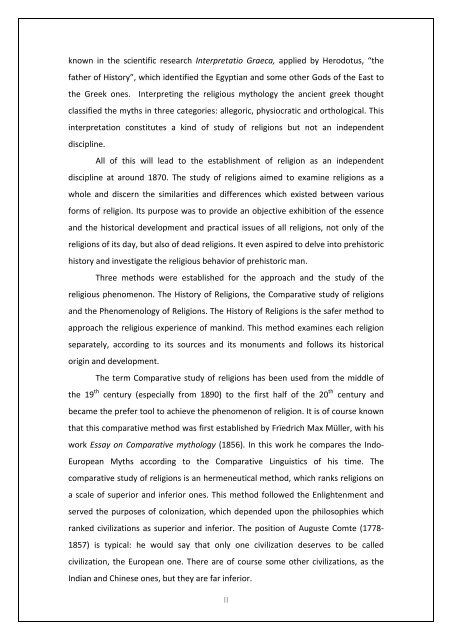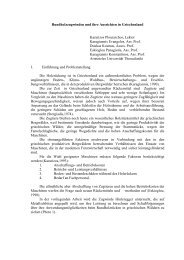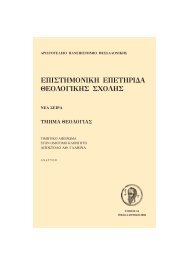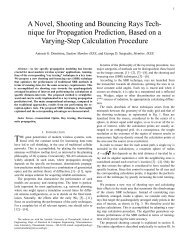The study of Religions in Greece: a case of transition
The study of Religions in Greece: a case of transition
The study of Religions in Greece: a case of transition
You also want an ePaper? Increase the reach of your titles
YUMPU automatically turns print PDFs into web optimized ePapers that Google loves.
known <strong>in</strong> the scientific research Interpretatio Graeca, applied by Herodotus, “the<br />
father <strong>of</strong> History”, which identified the Egyptian and some other Gods <strong>of</strong> the East to<br />
the Greek ones. Interpret<strong>in</strong>g the religious mythology the ancient greek thought<br />
classified the myths <strong>in</strong> three categories: allegoric, physiocratic and orthological. This<br />
<strong>in</strong>terpretation constitutes a k<strong>in</strong>d <strong>of</strong> <strong>study</strong> <strong>of</strong> religions but not an <strong>in</strong>dependent<br />
discipl<strong>in</strong>e.<br />
All <strong>of</strong> this will lead to the establishment <strong>of</strong> religion as an <strong>in</strong>dependent<br />
discipl<strong>in</strong>e at around 1870. <strong>The</strong> <strong>study</strong> <strong>of</strong> religions aimed to exam<strong>in</strong>e religions as a<br />
whole and discern the similarities and differences which existed between various<br />
forms <strong>of</strong> religion. Its purpose was to provide an objective exhibition <strong>of</strong> the essence<br />
and the historical development and practical issues <strong>of</strong> all religions, not only <strong>of</strong> the<br />
religions <strong>of</strong> its day, but also <strong>of</strong> dead religions. It even aspired to delve <strong>in</strong>to prehistoric<br />
history and <strong>in</strong>vestigate the religious behavior <strong>of</strong> prehistoric man.<br />
Three methods were established for the approach and the <strong>study</strong> <strong>of</strong> the<br />
religious phenomenon. <strong>The</strong> History <strong>of</strong> <strong>Religions</strong>, the Comparative <strong>study</strong> <strong>of</strong> religions<br />
and the Phenomenology <strong>of</strong> <strong>Religions</strong>. <strong>The</strong> History <strong>of</strong> <strong>Religions</strong> is the safer method to<br />
approach the religious experience <strong>of</strong> mank<strong>in</strong>d. This method exam<strong>in</strong>es each religion<br />
separately, accord<strong>in</strong>g to its sources and its monuments and follows its historical<br />
orig<strong>in</strong> and development.<br />
<strong>The</strong> term Comparative <strong>study</strong> <strong>of</strong> religions has been used from the middle <strong>of</strong><br />
the 19 th century (especially from 1890) to the first half <strong>of</strong> the 20 th century and<br />
became the prefer tool to achieve the phenomenon <strong>of</strong> religion. It is <strong>of</strong> course known<br />
that this comparative method was first established by Frïedrich Max Müller, with his<br />
work Essay on Comparative mythology (1856). In this work he compares the Indo‐<br />
European Myths accord<strong>in</strong>g to the Comparative L<strong>in</strong>guistics <strong>of</strong> his time. <strong>The</strong><br />
comparative <strong>study</strong> <strong>of</strong> religions is an hermeneutical method, which ranks religions on<br />
a scale <strong>of</strong> superior and <strong>in</strong>ferior ones. This method followed the Enlightenment and<br />
served the purposes <strong>of</strong> colonization, which depended upon the philosophies which<br />
ranked civilizations as superior and <strong>in</strong>ferior. <strong>The</strong> position <strong>of</strong> Auguste Comte (1778‐<br />
1857) is typical: he would say that only one civilization deserves to be called<br />
civilization, the European one. <strong>The</strong>re are <strong>of</strong> course some other civilizations, as the<br />
Indian and Ch<strong>in</strong>ese ones, but they are far <strong>in</strong>ferior.<br />
II
















